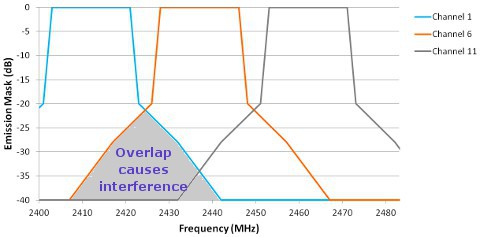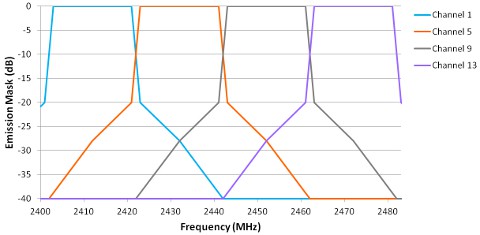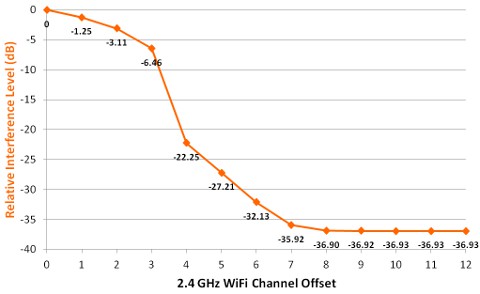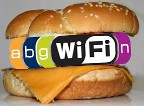Tuesday 12 February, 2013, 14:24 - Radio Randomness, Spectrum Management
One issue with WiFi that crops up regularly is that of selecting which channel to use. This is a subject on which several previous articles have been written, however the discovery of a 2004 paper by Cisco entitled 'Channel Deployment Issues for 2.4-GHz 802.11 WLANs', looks at whether or not it is possible to seat WiFi hotspots on neighbouring channels and the effect that channel separation has on performance. Though the paper is now nearly 10 years old, it remains one of the only references on the issue.
What the paper says, quite rightly, is that the extent to which a WiFi hotspot will cause interference to a neighbouring one is dependent on the extent to which interference from one is received by the other. This is partially a factor of the distance between them but is also related to their frequency separation. What the paper shows is that, in the USA, where there are 11 2.4 GHz WiFi channels available, only the set of channels 1, 6 and 11 are usable in such a way that a hotspot on one will not interfere with hotspots on the others. The paper examines what would happen if the set of channels 1, 4, 8 and 11 were used for four neighbouring hotspots. Cisco even did some tests which showed the following results:
| Channels Used | Throughput per Client |
|---|---|
| 1, 1, 6 and 11 | 601 KB/second |
| 1, 4, 8 and 11 | 349 KB/second |
What the results indicate is that even though, in the first test, two of the hotspots were on the same channel, the average throughput was increased over the four channel example because the overall level of interference was reduced. The paper also notes that WiFi hotspots on the same channel recognise each other and use various measures to try and avoid interfering whereas those on neighbouring channels just see interference on the channel. This is one reason why it is better to use a set group of channels in a given area (and to see what your neighbours are doing) rather than just pick a channel at random.
Having read this paper, the question that immediately arose was whether or not the fact that in Europe (and certain other parts of the world) there are 13 2.4 GHz WiFi channels available and not 11, offers up the possibility of a four channel arrangement that actually works - channels 1, 5, 9 and 13. The diagrams below show the emissions that are produced by the hotspots in the original three and proposed European four channel arrangements.

Three channel arrangement

Four channel arrangement
The amount of interference that is caused between devices is the overlapping area of the emissions of one transmitter with that of the receiver of a device on another channel (shown shaded on the first diagram). Using the standard emission mask to represent the emissions from one device (in reality they are usually lower than this) and using the same mask to represent the characteristics of the receiver of another (again a reasonable assumption) the extent to which a transmission on one channel is received by a receiver on another channel can be easily calculated.
The chart below shows how much of the emissions of a transmitter on a given channel are received by a receiver which is offset by a certain amount from that channel.

An offset of zero means that both are on the same channel and therefore the interference is at 100% (shown as 0 dB). When the transmitter and receiver are separated by one channel (eg one hotspot is on channel 6, the other on channel 7), the amount of interference that one causes the other reduces by 1.25 dB (representing around 75% of the original value). When this offset is increased to two channels (eg one hotspot on channel 5, the other on channel 7), the interference falls by 3.1 dB (or around 50%). At the extreme, when the offset reaches 8 channels or more, the interference has fallen by nearly 37 dB (or to around 0.02% of the original value). So...
- In the case of the use of channels 1, 6 and 11 where the offset is 5 channels it can be seen that the level of mutual interference between hotspots would be -27 dB (or around 0.2%).
- In the case of the use of channels 1, 5, 9 and 13 where the offset is 4 channels it can be seen that the level interference between hotspots would be -22 dB (or around 0.6%).
- In the case of the use of channels 1, 4, 8 and 11 where the offset falls to 3 channels, the level interference between hotspots rises dramatically -6.4 dB (or around 23%).
It is therefore, perhaps, no great surprise that using the four channel arrangement posed by Cisco that interference levels increased to the point that the throughput dropped by nearly half. It does, however, look feasible that in Europe the use of a four channel arrangement that uses channels 1, 5, 9 and 13 might be feasible. A lot will depend on the characteristics of the receivers in use and whether they are as good as the emission mask.
 Don't worry if you haven't understood everything presented here, the salient points are:
Don't worry if you haven't understood everything presented here, the salient points are:
- In the USA and other places where there are only 11 WiFi channels available, throughput will be maximised if everyone in the same neighbo(u)rhood stuck to using only channels 1, 6 or 11.
- In Europe and other places where there are 13 WiFi channels available, it seems quite feasible that if everyone sticks to using channels 1, 5, 9 or 13, the performance of everyone's WiFi hotspots would be maximised.
- Using a WiFi hotspot on a channel which is offset from a nearby hotspot by 1, 2 or 3 channels is a recipe for both hotspots to suffer interference and have degraded performance.
- Randomly picking a channel for your WiFi hotspot (eg. setting it to your lucky number) is a recipe for poor performance all round.
It is perhaps worth noting that in the 5 GHz band, no such restrictions apply as, sensibly, all of the available channels are mutually independent from all the others!
Unfortunately, unlike Cisco, the Wireless Waffle team do not have a shed full of WiFi hotspots that can be used to do tests on throughput. Perhaps someone might like to take up this challenge and let us know what the results are?
